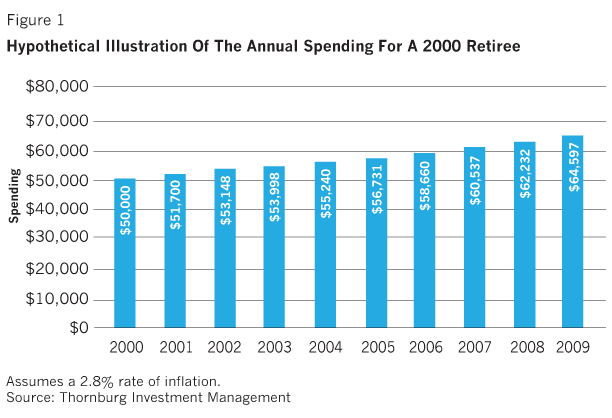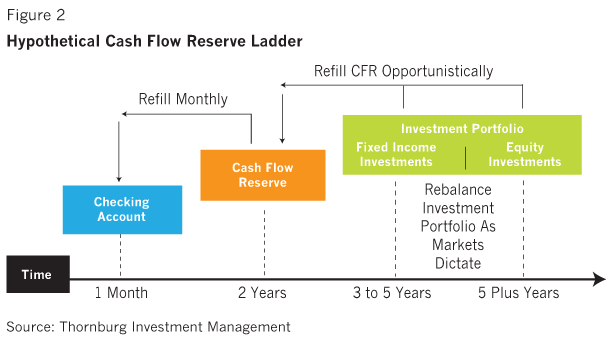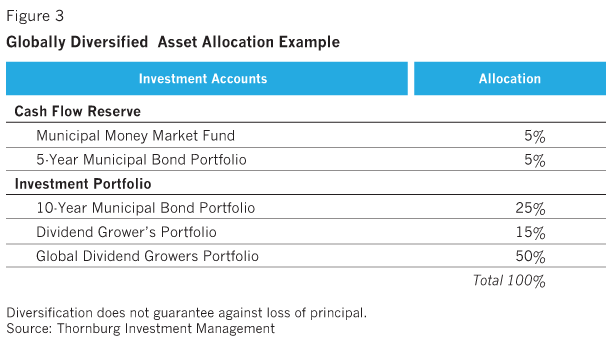As we have all experienced over the past few years, retirement plans designed to fund annual spending solely through the sale of their assets are exposed to the vagaries of the market. Therefore, we will outline how to convert the retirement savings to a monthly spending amount, using an approach that balances the need for current income and future growth.
The objective of this conversion process is to utilize the strategies outlined in this series to build the framework that may help a retiree sustain a lengthy retirement time frame. This process will use a globally diversified portfolio with a cash-flow-reserve ladder structure that strives to generate an attractive level of current income with the possibility for growth.To illustrate how the conversion process is meeting this objective, we will use a hypothetical illustration of a retiree who began retirement on January 1, 2000 (2000 retiree) with $1 million in retirement savings and spending 5% of the assets in year one ($50,000), then indexing to inflation. For this 2000 retiree, the amount needed to keep pace with inflation from 2000 to 2009 (rate of inflation per the Consumer Price Index (CPI) (averaged 2.89% annually for this period) can be seen in the bar graph in Figure 1.

Note that the annual spending amount increased from $50,000 to $64,597 (29.2%) during this ten-year time frame. Also keep in mind that during this period, the financial markets experienced two severe bear markets, one in 2000-2002 and another in 2007-2008. This environment will provide a good test case to see the functioning of a defined structure designed to convert the retirement savings to a monthly spending amount.
Cash-Flow-Reserve Ladder
To provide a structure to the conversion process, we will use the cash-flow-reserve ladder. This ladder provides three rungs aligning the most liquid investments to fund near-term spending needs, while the more volatile, growth-oriented investments are held inside a diversified portfolio with a five-year investment horizon.
Using this cash-flow ladder, the retiree writes a check each month from the money market fund within the cash-flow reserve and deposits it into their checking account. In year one, the 2000 retiree would have written a monthly check for $4,167 ($50,000/12) from the money market account and deposited it into the checking account to cover the monthly spending. Providing a specified amount each month is a key attribute of the structure while also giving the retiree some separation from the larger pool of assets in the investment portfolio. This separation can help reduce the desire to overspend.

Within the various levels of investments from the cash-flow reserve and investment portfolios, the interest and dividend income generated will not initially be reinvested. Instead this income will be deposited into the money market fund to continually replenish the cash-flow reserve. However, if the income stream grows adequately enough to cover the spending amount and more, the excess is reinvested in the investment portfolio. The concept is to use a globally diversified portfolio that generates enough income to cover the current spending needs without having to sell assets. However, whatever portion of the spending is not covered by the current income will come from selling assets opportunistically into the market to refill the cash-flow reserve back to the two-year spending level.
Using A Globally Diversified Asset Allocation
Given the opportunities globally to invest in companies that have the ability and willingness to pay a high and growing dividend, the equity portion of the retirement portfolio will be allocated to these types of income investments. The balance of the portfolio will be allocated into municipal bond investments to help preserve capital, offer some diversification and provide a taxefficient interest income stream.

Utilizing the Cash-Flow-Reserve Ladder (Figure 3), the retirement portfolio has been allocated as follows:








